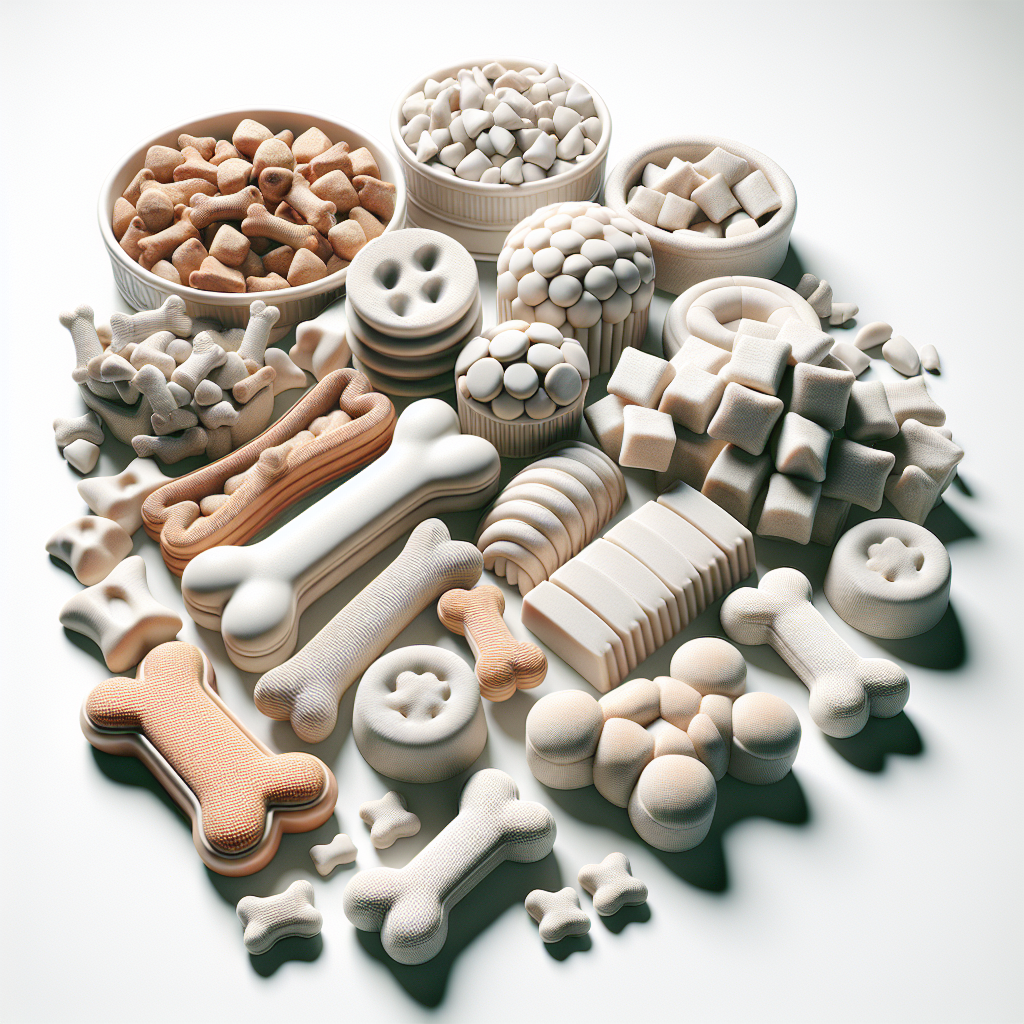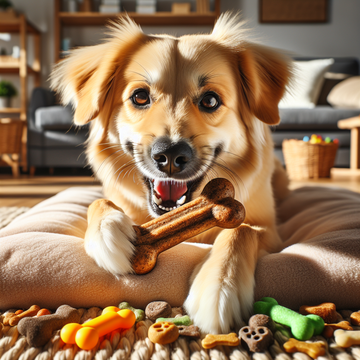What Are the Best Treats for Training a Dog? Find Out Here!
Training your dog can be a rewarding experience for both you and your furry friend. One of the most effective ways to reinforce positive behavior is by using treats. But what are the best treats for training a dog? The key is to find treats that your dog finds irresistible, yet are healthy and nutritious. High-value treats can make a significant difference in how your dog responds to training sessions. These are the treats that your dog absolutely loves and will do anything to earn.
When selecting training treats, it's important to consider a few key factors:
- Flavor: Choose treats with flavors that your dog enjoys. Common favorites include chicken, beef, and cheese.
- Size: Opt for small, bite-sized treats that are easy for your dog to consume quickly. This allows for multiple rewards during a training session without overfeeding.
- Ingredients: Look for treats made with high-quality, natural ingredients. Avoid treats with artificial additives, preservatives, or fillers.
- Calories: Training often involves numerous repetitions, so low-calorie treats are ideal to prevent weight gain.
At Happypup.dog, we offer a range of delicious and nutritious dog treats that are perfect for training sessions. Treat your furry friend to the joy they deserve with our range of delicious and nutritious dog treats.
Importance of High-Value Treats

When it comes to dog training, not all treats are created equal. High-value treats play a crucial role in ensuring your dog remains engaged and motivated during training sessions. But why exactly are these treats so important?
Firstly, high-value treats are typically more enticing to dogs than their regular kibble or everyday snacks. This heightened allure can be a powerful tool to capture your dog's attention, especially in distracting environments or when teaching complex commands. For instance, if you're training your dog in a park with numerous distractions, a high-value treat like a piece of chicken or cheese can help keep your dog focused on you.
Secondly, the use of high-value treats can accelerate the learning process. When a dog receives a highly desirable treat as a reward, the positive reinforcement is stronger, making it easier for the dog to associate the behavior with the reward. This leads to quicker and more consistent responses to commands.
Furthermore, high-value treats can be invaluable when working on behavior modification or addressing problem behaviors. If your dog is fearful or anxious, a high-value treat can help create a positive association with the situations that trigger these emotions, aiding in their desensitization.
Remember, the goal is to use these treats strategically. Reserve high-value treats for new or difficult tasks, and opt for more regular treats for simpler commands that your dog has already mastered. This ensures that the high-value treats retain their special status and effectiveness.
Healthy Treat Options for Dogs
While rewarding your dog is essential for successful training, it's equally important to ensure that the treats you offer are healthy. Overindulgence in unhealthy treats can lead to obesity and other health issues. Fortunately, there are plenty of *healthy treat options* that are both delicious and nutritious for your furry friend.
**Lean proteins** are an excellent choice for healthy dog treats. Options like chicken, turkey, and fish are high in protein and low in fat. Not only are they tasty, but they also provide the essential amino acids your dog needs for muscle development and overall health. To make these even healthier, consider boiling the meats without added oils or seasoning.
**Fruits and vegetables** are another great option. Many dogs love the sweet taste of apples, blueberries, and bananas or the crunch of carrots and green beans. These natural treats are packed with vitamins, minerals, and fiber, which can aid in digestion and overall health. However, always ensure that the fruits and vegetables you offer are safe for dogs, as some can be toxic, such as grapes and onions.
For those looking for convenience, there are **commercially available healthy dog treats** made from natural, high-quality ingredients. Look for products that are free from artificial additives, preservatives, and fillers. Ingredients like sweet potatoes, pumpkin, and whole grains can offer nutritional benefits while still being tasty.
Lastly, consider **homemade treats**. Making your own dog treats allows you to control the ingredients and ensure they are healthy. Recipes can range from simple baked biscuits to more elaborate dehydrated meat treats. This way, you can cater to your dog's specific dietary needs and preferences.
By opting for healthy treats, you not only keep your dog motivated during training but also contribute to their overall well-being. Always remember to balance treats with regular meals and monitor your dog's weight and health to avoid overfeeding.
Homemade vs. Store-Bought Treats

When it comes to choosing between *homemade* and *store-bought treats*, each option has its unique advantages and considerations. Understanding these can help you make an informed decision that best suits your dog's needs and your lifestyle.
**Homemade treats** offer a level of control and customization that is unmatched. By making treats at home, you can ensure that only high-quality, natural ingredients are used. This is particularly beneficial for dogs with allergies, sensitivities, or specific dietary requirements. You can tailor the treats to include ingredients your dog loves and avoid any that might cause adverse reactions. Additionally, homemade treats often come without preservatives, artificial colors, or flavors, making them a healthier option overall. The downside, however, is the time and effort required to prepare these treats, which may not be feasible for everyone.
On the other hand, **store-bought treats** offer convenience and variety. They are readily available and come in a wide range of flavors, textures, and types, catering to different preferences and training needs. Many reputable brands focus on producing healthy, high-quality treats made from natural ingredients, ensuring that you can still provide nutritious options without the hassle of homemade preparation. However, it's crucial to read the ingredient labels carefully. Some commercially available treats may contain artificial additives, fillers, and preservatives that are best avoided. Opt for brands that prioritize transparency and quality to ensure your dog receives the best.
Ultimately, the choice between homemade and store-bought treats depends on your personal preferences, schedule, and your dog's specific needs. Some pet owners find a balance by incorporating both types into their dog's diet, using homemade treats for special occasions or specific training sessions and store-bought treats for everyday rewards. Whichever option you choose, always prioritize your dog's health and well-being.
Tips for Using Treats Effectively

Using treats effectively during training sessions can significantly enhance your dog's learning experience and reinforce positive behaviors. Here are some essential tips to ensure you make the most out of treat-based training:
- Choose the Right Treats: Select treats that your dog finds highly motivating. These are often small, soft, and smelly. High-value treats, such as small pieces of chicken or cheese, can be particularly effective for difficult commands or distractions.
- Keep Treats Small: Training treats should be bite-sized to prevent your dog from becoming full too quickly. Small treats also allow for more repetitions during training sessions without overfeeding.
- Timing is Key: Deliver treats immediately after your dog performs the desired behavior. This helps your dog associate the action with the reward, reinforcing the behavior more effectively.
- Use Treats Sparingly: While treats are a powerful training tool, relying on them too much can lead to dependency. Gradually phase out treats by using them intermittently and supplement with other forms of rewards, such as verbal praise or playtime.
- Pair Treats with Praise: Always accompany treats with enthusiastic verbal praise or gentle petting. This helps build a positive association with the behavior and strengthens your bond with your dog.
- Train in Short Sessions: Keep training sessions brief and focused, typically 5-10 minutes. This prevents your dog from becoming bored or frustrated and keeps them eager to learn.
- Consistency is Crucial: Ensure everyone in the household is on the same page with training commands and treat usage. Consistent practices help your dog understand expectations and reinforce learning.
By following these tips, you can maximize the effectiveness of treat-based training and foster a more enjoyable and productive learning experience for your furry friend. Remember, patience and consistency are key to successful training.
Conclusion and Recommendations

In conclusion, understanding what are the best treats for training a dog is pivotal for effective and enjoyable training sessions. High-value treats, such as small pieces of meat or cheese, can be particularly motivating for dogs. Meanwhile, healthy treats like carrots or blueberries provide nutritional benefits while still being enticing. Remember to tailor the treat size to the training context, ensuring they are small enough to prevent overfeeding during extended sessions.
Using treats effectively involves not just the type of treat but also the timing and method of delivery. Immediate reinforcement helps dogs understand the connection between their actions and the reward, while pairing treats with verbal praise enhances the positive experience. Additionally, transitioning from treat-based rewards to other forms of positive reinforcement, like play or affection, can ensure balanced and sustainable training outcomes.
For pet parents looking to make the most out of their training efforts, exploring a variety of treat options and observing your dog's preferences can make a significant difference. Consistency, patience, and positive reinforcement are the cornerstones of successful dog training.
Treat your furry friend to the joy they deserve with our range of delicious and nutritious dog treats. Visit Happypup.dog to explore our selection and find the perfect training treats for your canine companion.






